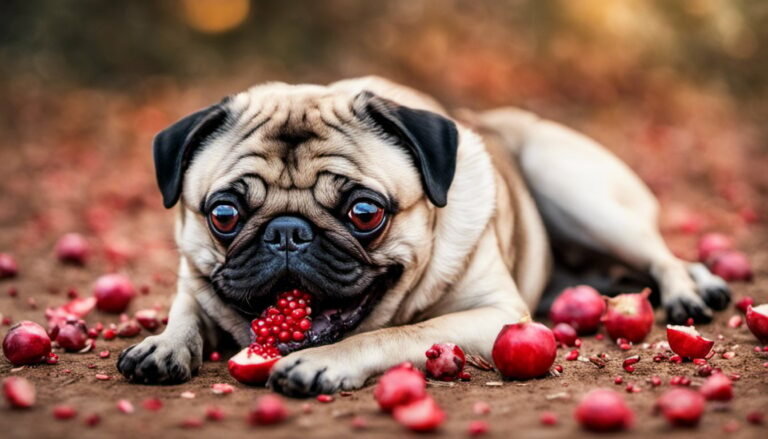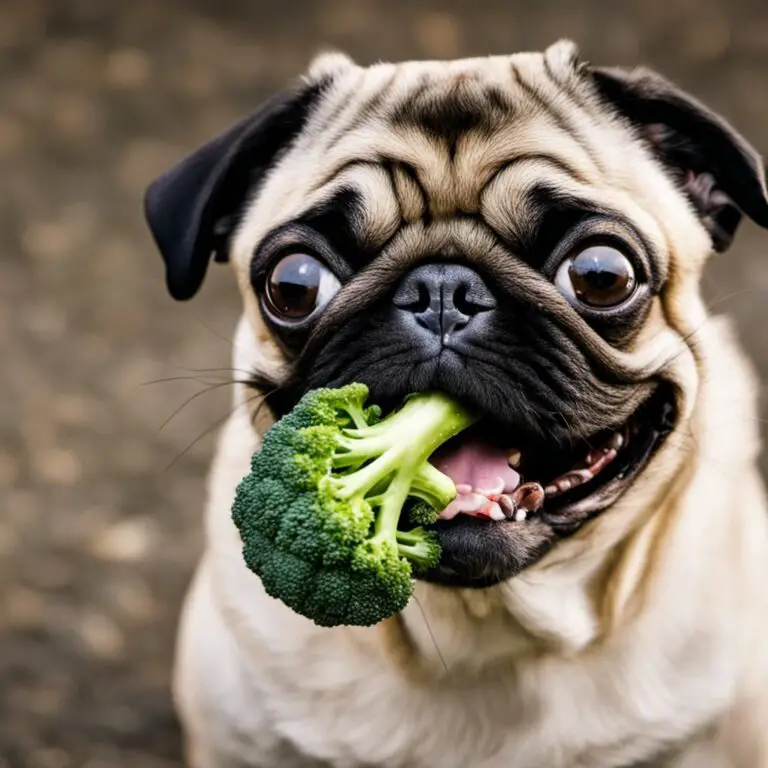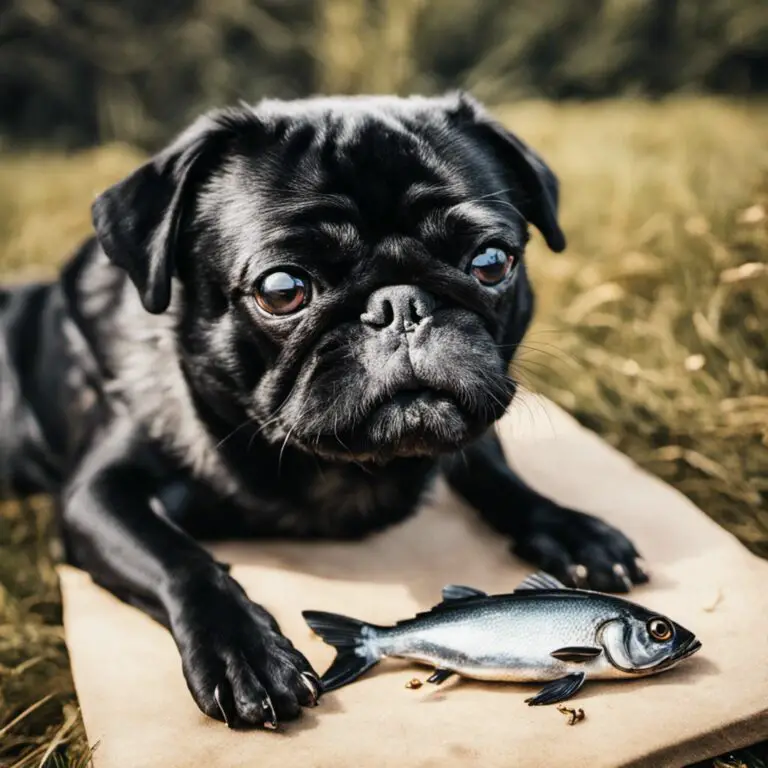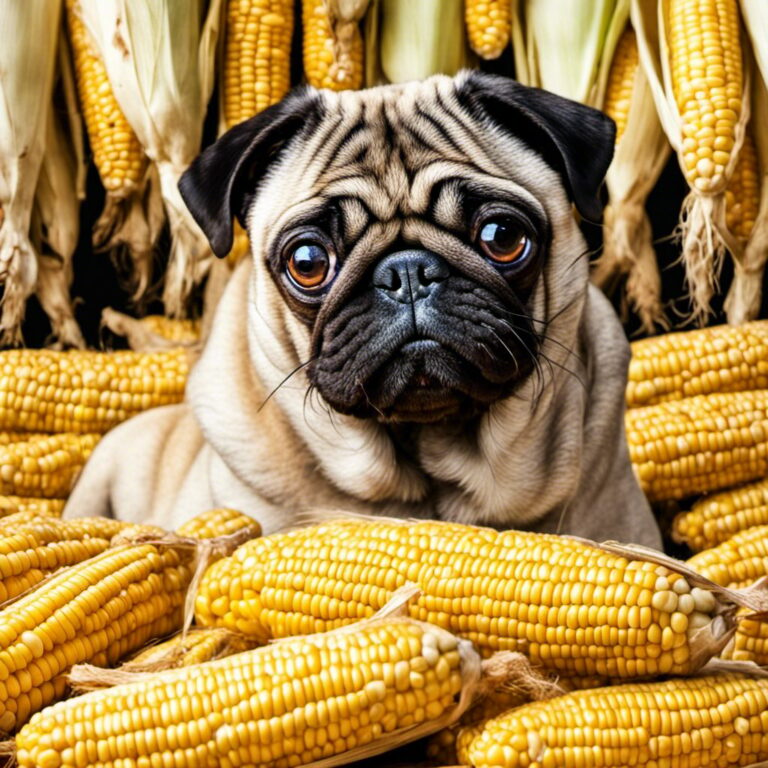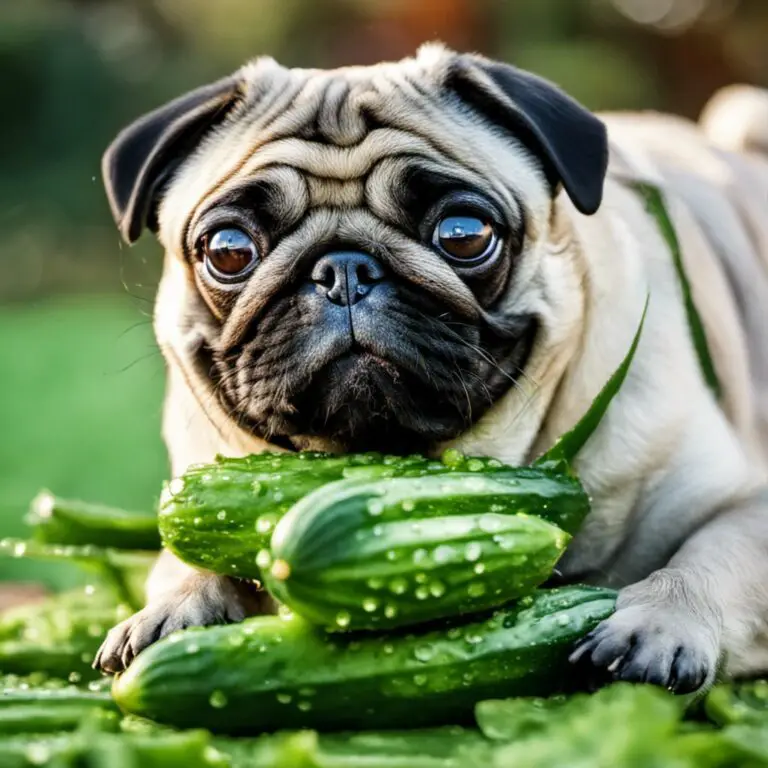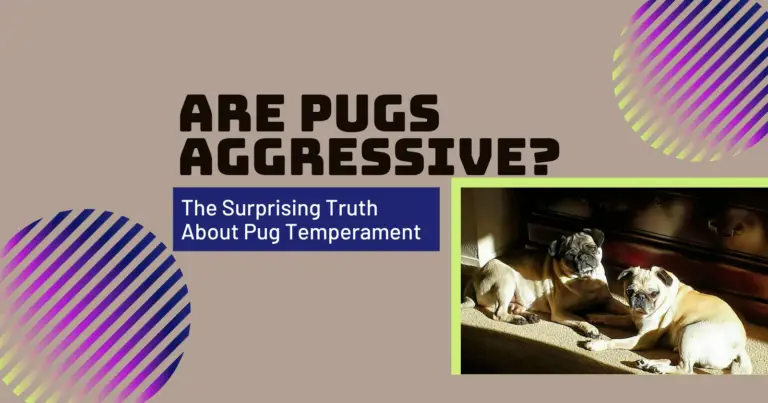Can Pugs Eat Lettuce? A Comprehensive Guide for Pet Owners

When it comes to feeding your beloved pug, you might wonder whether certain human foods, like lettuce, are safe for them to consume. Can Pugs Eat Lettuce? Many dog owners have this concern, and it’s crucial to understand the potential risks and benefits before introducing any new food into your pet’s diet.
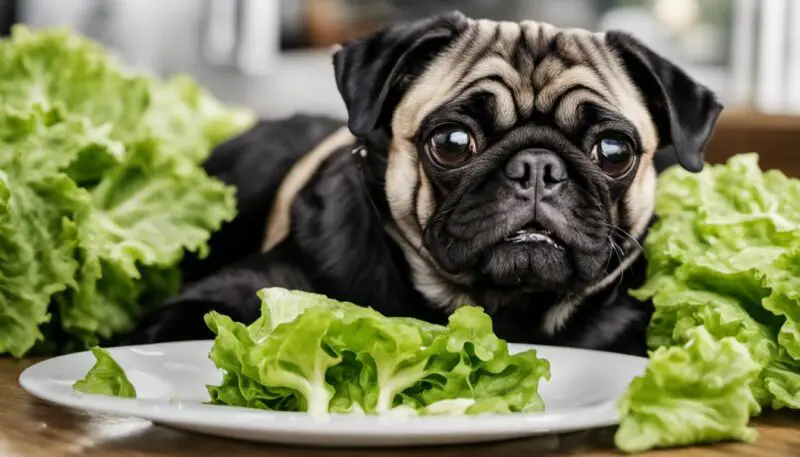
The good news is that lettuce, in general, is safe for dogs to eat, including pugs. Varieties such as romaine, arugula, and iceberg lettuce do not contain harmful ingredients for your dog, as they are mostly comprised of water – around 90 percent source.
That said, it’s essential to remember that dogs are primarily carnivores and should receive the majority of their nutrition from a portion of complete and balanced dog food. Feeding your pug lettuce is okay occasionally, but giving it as a treat or snack rather than a main component of their diet is best.
Contents
Table of Contents
Can Pugs Eat Lettuce?

Your pug can safely enjoy lettuce as a low-calorie and hydrating treat. In general, lettuce varieties such as romaine, arugula, and iceberg are safe for dogs since they contain no ingredients that can harm them. In fact, lettuce is 90% water and has very few calories, making it a light and refreshing snack for your pug 1.
Get The Free Food Eating Guide That Keeps My Pug Happy and Playful Even at 13 Years Old
100% Beginner Friendly & Lists Real Foods Your Pug Can Actually Eat!

When feeding your pug lettuce, start with a small amount to gauge their interest and watch for any adverse reactions. An appropriate serving size for a pug would be about 1/2 cup of washed and chopped lettuce per day 2. It’s important to ensure the lettuce is thoroughly cleaned to remove any pesticides or contaminants that might be harmful to your pet.
Lettuce can be an excellent addition to your pug’s diet due to its high water content and low-calorie count, but remember that it shouldn’t replace their main meal. While lettuce can provide some fiber and vitamins, but it doesn’t contain all the nutrients your pug needs to maintain a healthy and balanced diet.
Please keep in mind that your pug might have individual preferences and dietary needs. It’s always a good idea to consult with your veterinarian before introducing new foods into your pet’s diet to ensure their overall health and well-being.
Understanding the Dietary Needs of Pugs
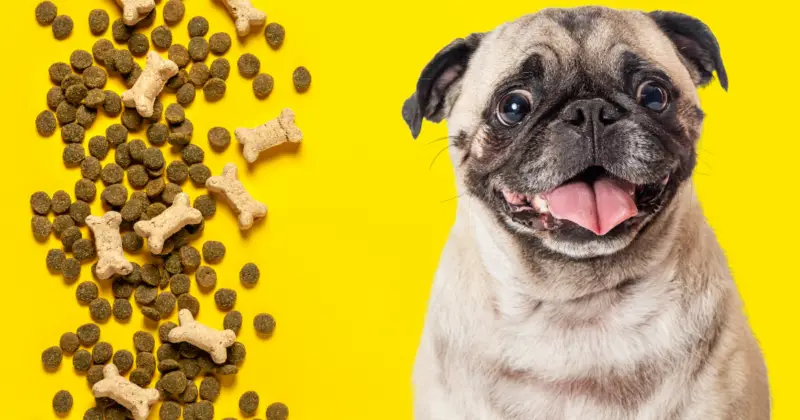
As a pug owner, it’s essential to understand your furry friend’s dietary needs to ensure their overall health and well-being. Knowing what makes a balanced diet and what food items to avoid will help you make informed decisions when feeding your pug.
Pugs require a diet that consists of sufficient water, protein, fat, vitamins, and minerals. Water is crucial in maintaining optimal body function; therefore, ensure your pug has access to fresh water at all times. When it comes to protein, a healthy pug diet should comprise about 18% crude protein, not exceeding 22%. The protein source can be derived from high-quality dog food or human food, such as chicken.
Your dog’s diet should also include healthy fats. Aim for around 5% crude fatty acids in the adult pug’s food and 8% in the puppy’s food intake. A balanced diet should contain the right balance of protein and fat, providing the necessary calories your pug needs. It may vary depending on factors like age, weight, size, gender, and activity level.
One example of the human food your pug can safely consume is carrots. In addition to being low in calories, carrots are rich in fiber and beta-carotene. However, it’s essential to offer carrots in moderation.
Including vitamins and minerals in your pug’s diet will ensure they get enough nutrients for their overall well-being. You can always consult your vet to suggest any specific supplements your pug might need.
In conclusion, providing a well-balanced diet tailored to the needs of your pug will help them maintain their health and happiness. Pay attention to their dietary requirements, and keep an eye on the foods they consume, ensuring they fulfill their nutritional needs.
Potential Benefits and Risks Associated with Feeding Lettuce to Pugs

Benefits of Lettuce for Pugs
Lettuce is a low-calorie vegetable that can be a healthy addition to your Pug’s diet, especially if they’re overweight. It is packed with essential nutrients like fiber, vitamin A, and vitamin C, which can benefit their overall health.
- Fiber: Adding lettuce to your Pug’s meal can provide them with a good source of fiber. Fiber is great for maintaining healthy digestion and bowel movements.
- Vitamin A: Lettuce contains vitamin A, which supports good vision, growth, and immune function in dogs.
- Vitamin C: This vitamin found in lettuce is an excellent antioxidant that helps maintain a strong immune system and neutralizes free radicals.
- Low-calorie: Since lettuce is low in calories, it can be a guilt-free treat for overweight Pugs who need to lose some pounds.
Risks of Feeding Lettuce to Pugs
While lettuce can have notable benefits for Pugs, there are also certain risks to keep in mind when incorporating it into their diet.
- Diarrhea and vomiting: Overfeeding lettuce may lead to diarrhea or an upset stomach in some dogs. It’s essential to introduce lettuce in moderation and gradually increase the amount if your Pug tolerates it well.
- Allergies: Some Pugs might have allergies to lettuce or experience gastric irritation. Keep an eye out for any signs of discomfort or allergic reactions after feeding lettuce to your Pug.
- Pesticides and bacteria: Ensure that you thoroughly wash lettuce to remove any residual pesticides, listeria, or E. coli bacteria before feeding it to your Pug.
In conclusion, while lettuce can be beneficial for your Pug in moderation, it is essential to consider these potential risks and monitor your dog’s response to this new addition to their diet.
Vegetables Pugs Can Eat
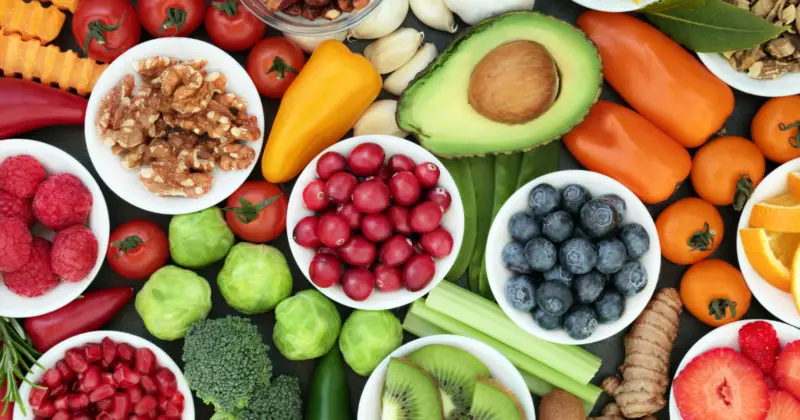
Other Safe Green Leafy Vegetables
In addition to lettuce, you can offer other safe green leafy vegetables to your pug. Spinach is a good choice, as it is high in vitamins and minerals, but it should be given in moderation due to its oxalate content, which can affect your dog’s kidney function if consumed in large amounts. Kale is also safe for your pug to eat and provides an excellent source of vitamins A, C, and K and calcium. When introducing any new vegetables to your pug’s diet, it’s crucial to start with small amounts and monitor their response.
Safe Non-Leafy Vegetables
There are also many safe non-leafy vegetables that you can feed your pug. Broccoli, for example, is a nutrient-dense vegetable that can be a healthy addition to your pug’s diet, but it should be given in small quantities, as large amounts can cause gastrointestinal issues. Cooked green beans are a low-calorie option that many pugs enjoy, and they provide a good source of vitamins and fiber.
Carrots are another popular vegetable for pugs and can be given either cooked or raw. They are rich in vitamins A, C, and K, as well as fiber, and can also serve as a low-calorie snack for your pug. Potatoes can be given to your pug in cooked form, but it’s important to avoid raw potatoes due to their solanine content, which can harm dogs. When serving potatoes to your pug, be sure to remove the skin and avoid adding any seasoning, such as salt or butter.
In conclusion, there are various green leafy and non-leafy vegetables, like spinach, kale, broccoli, green beans, carrots, and potatoes, that you can safely include in your pug’s diet. Always remember to introduce new vegetables gradually to see how your pug tolerates them, and be mindful of portion sizes to avoid overfeeding.
Can Pugs Eat Lettuce? Watch this
Safe Fruits for Pugs
As a pug owner, you may wonder which fruits are safe for your furry friend to enjoy. Luckily, there are a variety of fruits that can be beneficial for your pug’s health. This section will briefly discuss some safe fruits for your pug to consume.
Strawberries are a great choice for pugs, packed with vitamins and antioxidants. Just be sure to remove the leaves and slice the strawberries to prevent choking hazards. Similarly, blueberries are another excellent fruit option, as they are low in calories and antioxidants and can even help improve cognitive function in older dogs.
Mango is also safe for your pug and offers numerous health benefits. This fruit is rich in vitamins A, C, and E and various minerals. Remember to remove the mango’s pit and peel it before feeding it to your pet. Peaches also make for a tasty treat, but removing the pit to avoid choking or any potential harm from the trace amounts of cyanide in peach pits is essential.
Watermelon is a hydrating and refreshing treat that is perfect for hot summer days. So feel free to share a seedless watermelon slice with your pug, as it is rich in vitamins A, B6, and C and potassium. Apples are another safe option for your pug. They provide essential nutrients and fiber, but remember to remove the core and seeds before serving, as they contain cyanide which can be toxic to dogs.
Next up on the list are bananas, a potassium-rich fruit that can help lower the risk of heart disease and improve muscle function. However, due to their high sugar content, it’s best to feed bananas to your pug in moderation as a treat. Both pears and cherries can also be offered in small quantities, as long as you remove the seeds and pits before feeding them to your pug, as they also contain cyanide.
In conclusion, there are many safe and nutritious fruit options to incorporate into your pug’s diet, including strawberries, blueberries, mangoes, peaches, watermelon, apples, bananas, cherries, and pears. With their rich supply of vitamins, minerals, and antioxidants, these fruits can provide numerous health benefits and make for a great snack. Just be sure to feed them in moderation and properly prepare them to ensure your pug’s safety.
Foods Pugs Should Avoid
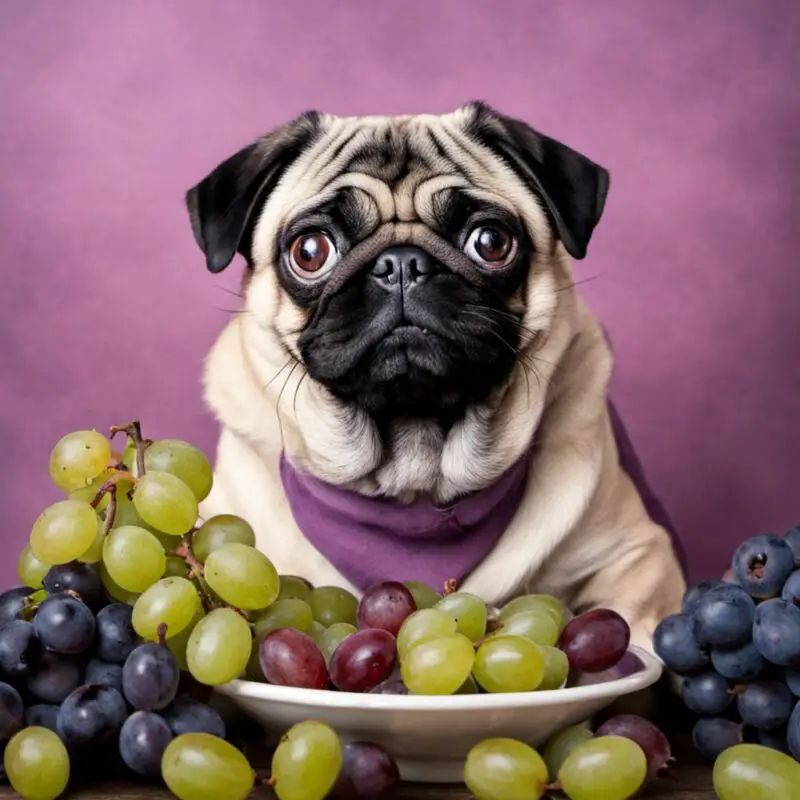
Knowing what foods your pug should avoid is essential to keep them healthy and safe. Some common food items may seem harmless to you, but they can pose severe risks to your pug’s health. In this section, we’ll cover several foods that you must keep away from your pug.
Firstly, you should never feed your pug onions, garlic, chives, or any other Allium family members. These foods are toxic to pugs and can damage red blood cells if consumed in large quantities. Additionally, the Allium family can cause gastrointestinal upset, which is unpleasant for both you and your pug.
Another harmful food for pugs is grapes and raisins, as they can lead to kidney failure in dogs. Even a small amount can cause severe symptoms, so keeping all types of grapes and raisins out of your pug’s reach is best.
It would be best if you also avoided feeding your pug avocados. Although some pet owners might disagree, the general consensus is that avocados contain a toxin called persin, which can cause mild to severe health issues in dogs. Signs of avocado ingestion include vomiting, diarrhea, and difficulty breathing.
Mushrooms are another food that your pug should avoid. Some mushrooms can be highly toxic to dogs, causing symptoms like vomiting, diarrhea, tremors, and even seizures. It’s best to keep all mushrooms away from your pug, as it’s challenging to differentiate between toxic and non-toxic varieties.
Your pug mustn’t consume caffeine as well. Caffeinated products like coffee, tea, and chocolate can cause rapid heart rate, tremors, and seizures in dogs. Be sure to keep these products out of your pet’s reach to prevent accidental ingestion.
In conclusion, it’s crucial to be mindful of your pug’s diet and ensure that they avoid consuming harmful foods like onions, grapes, avocados, mushrooms, and caffeine. By feeding your pug a healthy and appropriate diet, you’ll help keep them safe and in optimal health.
Potential Negative Effects of Certain Foods for Pugs

Toxic Foods and Poisoning
Some foods can be toxic to Pugs, leading to serious consequences. For example, dark chocolate contains theobromine, which is poisonous to Pugs, causing symptoms like vomiting, irregular heartbeat, tremors, seizure, and even death1. Similarly, avocado contains persin, a toxic substance that can lead to vomiting and diarrhea3. Onions, garlic, leeks, and chives, all Allium family members, can also be harmful to your Pug1.
Potential for Choking or Gastrointestinal Blockage
In addition to toxic foods, some items can pose choking hazards or cause gastrointestinal blockages in Pugs. Foods like cooked bones, large seeds, and pits should be avoided as they can get stuck in your dog’s throat or digestive tract. It’s crucial to pay attention to the size of treats and foods you’re giving your Pug to avoid such risks.
Allergic Reactions and Sensitivities
Just like humans, some Pugs may have allergies or sensitivities to particular foods. Symptoms can include gastrointestinal issues such as diarrhea, vomiting, and skin reactions like itching or rashes2. Common food allergens for dogs include wheat, soy, dairy, and eggs. It’s essential to monitor your Pug closely when introducing new foods and consult with your vet if you suspect they have a food allergy.
By being knowledgeable about potential hazards in your Pug’s diet, you can make informed choices that will keep them healthy and happy. Always consult with your veterinarian for personalized guidance on the best diet for your Pug.
Consulting With Your Vet Before Changing Your Pug’s Diet

Before introducing lettuce or any new food into your pug’s diet, it is essential to consult with your veterinarian. They will help you understand the nutritional benefits and potential risks associated with the changes you are considering. Additionally, your vet will be able to provide personalized recommendations based on your pug’s current health condition, age, and specific needs.
When discussing your pug’s diet with your vet, ask about the appropriate quantity of lettuce to include and how often it can be given. This will help you ensure that your pug is receiving balanced nutrition and not overloading on any particular food item.
Incorporating lettuce into your pug’s meals should be done gradually to avoid any upset stomach or digestive issues. Keep an eye on your pug after introducing the new food, and monitor their behavior and reactions. Contact your vet immediately for guidance if you notice any signs of distress or problems.
Remember that not all types of lettuce are suitable for your pug, so make sure to ask your vet which varieties they recommend and how they should be prepared. By ensuring that you are knowledgeable about lettuce’s properties and nutritional content, you can be confident in providing your pug with a safe and healthy addition to their diet.
In conclusion, consulting with your veterinarian is essential in making any changes to your pug’s diet. By working with your vet, you can ensure your pug receives the best possible nutrition, helping them enjoy a long, happy and healthy life.
Balanced Diet and Proper Feeding Practices

Feeding your Pug a balanced diet is crucial for their overall well-being. Providing them with the right nutrients in appropriate quantities will ensure they maintain a healthy weight, have a shiny coat, and stay energetic. Here are some key points to consider when planning your Pug’s diet:
When it comes to a Pug’s diet, water is essential because they tend to get dehydrated more easily than other breeds. Ensure that your Pug always has access to fresh, clean water.
Pugs require adequate nutrition to stay healthy, which means balancing calories, fat, protein, and minerals. A high-quality commercial dog food designed for small breeds could satisfy these needs, or you can also consider a homemade diet with recommendations from your veterinarian. For instance, the Royal Canin Breed Health Nutrition Pug Dry Dog Food is specially formulated for purebred pugs aged 10 months and up.
Introducing some fruits and vegetables like lettuce into your Pug’s diet can be beneficial due to their high water content and their low-calorie count. Lettuce, particularly romaine, arugula, or iceberg varieties, is generally safe for Pugs to eat since it contains no toxic components. However, moderation is key, as too much lettuce might cause digestive issues or diarrhea.
Proper feeding practices for your Pug should ideally include several small meals throughout the day. This can help prevent overeating, aid digestion, and maintain a steady energy supply. Monitor your Pug’s weight regularly and adjust their food intake based on age, activity level, and physical condition.
To summarize, focus on providing your Pug with a varied and balanced diet that supplies all the necessary nutrients to keep them healthy. Alongside incorporating proteins like eggs and safe fruits and vegetables such as lettuce, consistently monitor their weight and always ensure they have access to fresh water. Following these guidelines, you can maintain your Pug’s health and overall well-being.
Frequently Asked Questions: Can Pugs Eat Lettuce
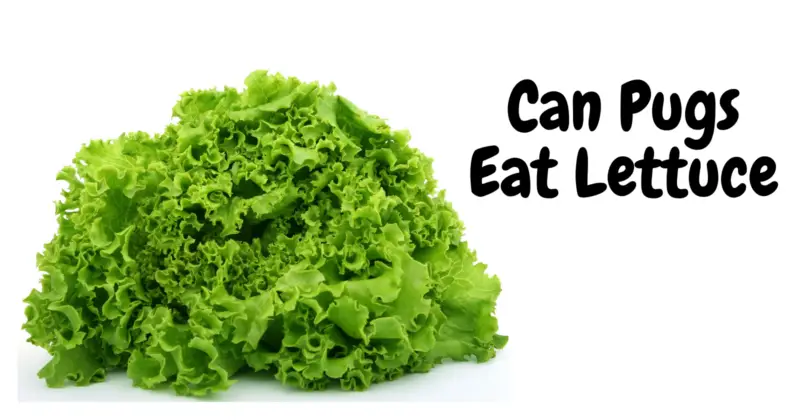
Is lettuce safe for pugs to consume?
Yes, lettuce is generally safe for pugs to consume. Varieties like romaine, arugula, and iceberg lettuce do not contain ingredients that can harm your dog, as lettuce is mostly made up of water and fiber source.
What are the benefits of lettuce for dogs?
While lettuce does not provide significant nutritional benefits for dogs, it can serve as a low-calorie and hydrating snack. Its high water and fiber content may also help with maintaining a healthy digestive system source.
Can lettuce be harmful to pugs?
Though lettuce is generally safe for pugs, feeding them too much can lead to diarrhea or an upset stomach. This is due to the high water and fiber content in lettuce source.
How much lettuce is appropriate for a pug?
As lettuce should only be fed as an occasional treat, a small amount like a few leaves can suffice. Remember that lettuce should not replace a balanced and nutritious diet designed specifically for your pug source.
Are there specific types of lettuce to avoid?
It is best to stick to common lettuce varieties like romaine, arugula, and iceberg. Avoid feeding your pug any lettuce treated with herbicides, pesticides, or other chemicals as these can be harmful to your dog source.
Should lettuce be combined with other foods for pugs?
Lettuce can be combined with other dog-friendly foods as a treat. However, it is essential to remember that pugs require a diet rich in protein and fats to thrive. If you are unsure about creating a balanced meal plan for your pug, consult with a veterinarian or a pet nutritionist for guidance on what to feed them source.

